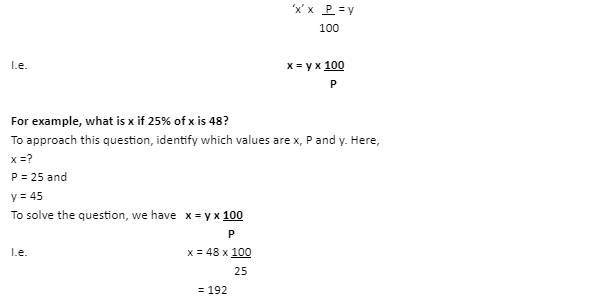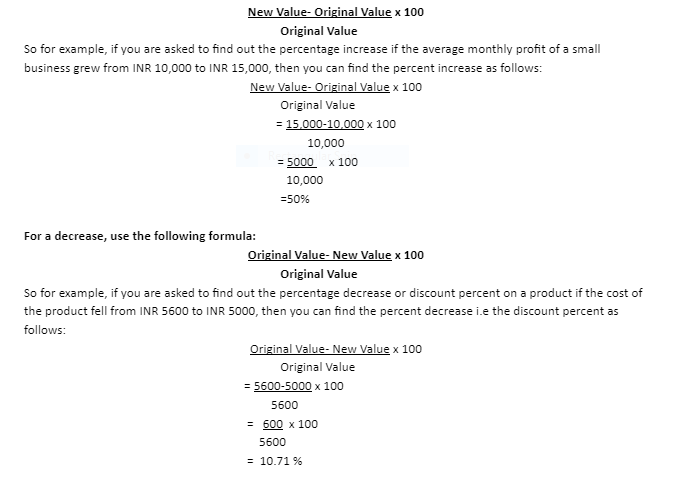Percentage Calculator (Online) - Percentage Formula
Calculate The Percentage
Benefits
00
What is the meaning of Percent or Percentage?
In a variety of situations, one is required to make calculations in terms of percentage or percent as it is commonly called.
Conversion to or from percentages are very common and a source of great confusion to many people. So the natural question that arises is what is the meaning of percent ?
The word percent (per cent) How do you find a percentage using a calculator literally means per hundred units of something . So when you say 25% of something, it means 25 units per 100 hundred units of the total. The word percentage and percent are often used interchangeably.
What is the meaning of x % of y?
Now that we know what is meant by percent, the real concern is how to actually calculate percentages. The wording of various percentage questions can be a little tricky but here is a complete easy tutorial of calculating percentages.
The meaning of x% of y means that out of a total of y, what will be the value of 33%. When you are asked to find x % of y, it is calculated as
x X y ÷ 100
So for example, if you are asked to find out: What is 33% of 50? Then it will be calculated as follows:
Ans: Here, x=33 and y=50. So we will find 33% of 50 as:
33 x 50 ÷ 100 = 16.5
What percent of x is y?
Another aspect we are faced with is to find what percent of a total is a given figure. For example, if you have scored 45 marks in a test which was of total marks of 100, then to find what percent of 60 is 45, we will have to convert the two figures into a fraction in the format - Given Figure (y/x) and then multiply it with 100 to convert it into percent.
Total Figure
So the formula you must use is:
Given Figure x 100 ÷ Total Figure
For example, if you are asked to find what percent of 60 is 45, then in this problem x=60 and y=45 So, to find the percentage the calculation will be as follows:

What is x if P% of it is y?
This may be another way to twist around a question of simple percentage. But the meaning and approach to solve it is really simple and you just need to crack the meaning of the statement first to understand it properly. When it is asked: What is x if P% of it is y?, the meaning is that a x is the total figure and P% of it is y, I.e. The total amount is x, the percentage is P and the calculated answer of P% of x is equal to y. You are given the value of y and P and you have to find out x. To calculate this, you have to use the simple formula:

Difference in percent: Percentage Increase or Decrease
Another common calculation in the context of percentages involves the question of percentage increase or decrease. These questions are commonly involved in stocks, sensex, discounts, population rates, profit and loss, overall performance over years and many more
So it is important to understand how a percentage increase or decrease is calculated. The first thing to keep in mind is that the increase/decrease is always calculated against the original figure.
- The first step is to find out the numerical increase or decrease in the values (in the unit of the original figures). This is done by:
- Subtracting the new value from the original value in case of a decrease.
- Subtracting the original value from the new/changed value in case of an increase.
- After this, you have to find out the proportion of the increase/decrease, in comparison to the original value. This is done by taking the numerical increase/decrease as the numerator and the original value as the denominator, i.e. Numerical Increase / Decrease ÷ Original Value
- To find the percentage increase or decrease, all you have to do is multiply the above fraction by 100
To sum up the entire process, here we have provided easy formulae that you can use:
For an increase, use the formula given below:

How to Convert Percent to Fraction and Vice Versa?
To think about it, a percentage is also a fraction. As the word per cent itself means, per hundred, it represents a fraction, so 39% would mean 39 out of every 100 units or in other words, 39/100.
A fraction consists of a numerator (numerical value which occurs above the fraction line) and the denominator (numerical value which occurs below the fraction line).
To convert a percentage into a fraction, write the percent value as the numerator and take 100 as the denominator and then reduce it to the lowest possible value in terms of canceling through common factors.
So to simply convert 75% into a fraction, write it as 75 and then start reducing it using the highest common factor,
in this case 25, so the simplest reduced fraction will be 3 ÷ 4
To do the vice versa, i.e. to convert the fraction to a percent, you have to simply multiply the fraction by 100 and find the percent value. So if you have to convert the fraction 3 ÷ 5 into a percent, you can do it as follows:
3 ÷ 5 x 100
= 60%
How to Convert Percent to Decimal and Vice Versa?
The conversion of a percentage to decimal and vice versa is the simplest. All you have to remember is two thumb rules:
- If you want to convert a percent to decimals, move the decimal point two places to the left from the one‘s place.
- If you want to convert a decimal to a percentage, simply multiply the figure by 100 or move the decimal point two places to the right.
So for example if you want to convert 6.598 to percentage, move the decimal point two places to the right, i.e. 659.8.
If you want to convert 93.65% to decimals, move the decimal points two places to the left, which means 0.9365.
It‘s really that simple!!
Percentage Chart with Ratio, Fraction & Decimal
Fractions, Ratios, Percents and Decimals are interrelated with each other. Let us look at the conversion of one form to another:
| S.no | Ratio | Fraction | Percent(%) | Decimal |
| 1 | 1:1 | 1/1 | 100 | 1 |
| 2 | 1:2 | 1/2 | 50 | 0.5 |
| 3 | 1:3 | 1/3 | 33.333 | 0.3333 |
| 4 | 1:4 | 1/4 | 25 | 0.25 |
| 5 | 1:5 | 1/5 | 20 | 0.20 |
| 6 | 1:6 | 1/6 | 16.667 | 0.16667 |
| 7 | 1:7 | 1/7 | 14.285 | 0.14285 |
| 8 | 1:8 | 1/8 | 12.5 | 0.125 |
| 9 | 1:9 | 1/9 | 11.111 | 0.11111 |
| 10 | 1:10 | 1/10 | 10 | 0.10 |
| 11 | 1:11 | 1/11 | 9.0909 | 0.0909 |
| 12 | 1:12 | 1/12 | 8.333 | 0.08333 |
| 13 | 1:15 | 1/13 | 7.692 | 0.07692 |
| 14 | 1:14 | 1/14 | 7.142 | 0.07142 |
| 15 | 1:15 | 1/15 | 6.66 | 0.0666 |
Explore our Popular Online Course
| MBA Online | BCA Online |
| MCA Online | B.Com Online |
| M.Com Online | BBA Online |
| M.Sc Online | B.Sc Online |
| One Year MBA Online | Click Here For More Online Programs |
A Quick Insight of College Vidya
The online education market in India remains disorganised, making it difficult for students to find relevant resources. We are the first online platform in India to consolidate all of the available online learning universities into a single location.
College Vidya equips students with the tools they need to enrol in top online universities. Our compare tool allows you to quickly and easily evaluate different online colleges based on a variety of criteria, including tuition, e-learning system, EMI, faculty, and more
FAQs Percent Calculator
A percentage calculator works by converting a given fraction or decimal to a percent figure.
For converting a figure to percent, you must find the total figure against which it is being compared, and then multiply the obtained fraction by 100 by using the formula:
Given Figure x 100 ÷ Total Figure
To find 20% of a number, simply multiply the number by 20/100.
Two find the percentage difference between two numbers, subtract the smaller number from the larger number and then find the fraction with respect to the two numbers and multiply by 100, i.e. once with respect to the smaller number and once with respect to the larger number.
To calculate percentage increase or decrease, use the formula:
Larger Value-Smaller Value x 100 ÷ Original Value
To calculate the discounted price of a product, follow these simple steps:
- Convert the percent to fraction, i.e. x% becomes x/100
- Multiply the fraction with the original price of the product, i.e. x ÷ 100, x Original Price of Product.
- Subtract the obtained value from the original price, the answer will be your discounted price.
To find the discount percent of a product, use the formula:
Discount Amount x 100 ÷ Original Price
To convert a percent to fraction (e.g. x%), simply write it in fraction form as x ÷ 100 and then reduce it to the simplest terms
To calculate percent using a calculator, write the fraction, for e.g. 65 out of a total of 80, as 65 / 80 and then simply click on the ’%‘ button on the calculator. This gives you the percentage of 65 out of a total of 80.
Get Free Consultation
Your Information Is Secure With Us.All Calculators
- Online University ROI Calculator
- Education Loan EMI Calculator
- Percentage Calculator
- BMI Calculator
- INR to USD Converter
- Return on Investment (ROI) Calculator
- Fraction Calculator
- Gallon To Liter Calculator
- Meter & Feet Calculator
- Age Calculator
- SGPA To Percentage Calculator
- CGPA To Percentage Calculator
- GPA To Percentage Calculator
- Inch To Centimeter Calculator
- Cat Percentile Calculator
- acre to square feet calculator
- acres to square meters calculator
- billion to rupees calculator
- binary to hex calculator
- centimeters to millimeters calculator
- centimeter to feet calculator
- centimeter to meter calculator
- cubic foot to cubic meter calculator
- decameters to meters calculator
- decimal to fraction calculator
- feet to centimeters calculator
- hectare to acre calculator
- hours to minutes calculator
- inches to feet calculator
- kilometer to miles calculator
- lbs to kg calculator
- meter to inch calculator
- meter to kilometer calculator
- meter to millimeter calculator
- meters to centimeters calculator
- millimeter to inches calculator
- millimeters to centimeters calculator
- million to crore calculator
- million to lakhs calculator
- million to rupees calculator
- square foot to square meter calculator
- square meter to square feet calculator
- volume of cuboid calculator

